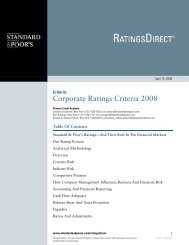European Infrastructure Finance Yearbook - Investing In Bonds ...
European Infrastructure Finance Yearbook - Investing In Bonds ...
European Infrastructure Finance Yearbook - Investing In Bonds ...
You also want an ePaper? Increase the reach of your titles
YUMPU automatically turns print PDFs into web optimized ePapers that Google loves.
8%, on the previous comparable period.<br />
Further downside risk cannot be excluded,<br />
however, and overall yields may come under<br />
significant pressure as ferry companies<br />
aggressively and increasingly compete for<br />
market share.<br />
The new approach has also yielded better<br />
visibility in terms of traffic forecasting, as some<br />
major customers have entered into multi-year<br />
contracts with Eurotunnel. These contracts enable<br />
customers to lock in their requirements in terms<br />
of number of crossings, and enable Eurotunnel to<br />
fine-tune its capacity planning. Further<br />
refinements of this approach are planned<br />
for 2007.<br />
Car shuttles.<br />
Standard & Poor’s considers that this segment<br />
will be relatively stable in the future.<br />
Eurotunnel’s share of the passenger car market<br />
on the short straits link has reduced to 43.5% in<br />
2006 from 45.5% in 2004. This was largely due<br />
to SpeedFerries’ entry into the market in May<br />
2005, to the gradual increase in Norfolkline’s<br />
passenger capacity in 2005 and 2006, and to the<br />
impact of Eurotunnel’s new commercial strategy.<br />
The new Eurotunnel strategy implemented<br />
during 2005 has focused on improving yields<br />
through dynamic ticket pricing after taking into<br />
account the load factor and time of arrival,<br />
changing the customer mix in favor of the nondaytrip<br />
passengers versus the daytrip passengers,<br />
and implementing a 34% reduction in capacity,<br />
with less availability for daytrip passengers.<br />
With this strategy, Eurotunnel has been able to<br />
increase the load factor on its passenger shuttles<br />
to 62.5% in 2006 from 45.1% in 2004, and car<br />
revenues by 10% (due to the 11% increase in the<br />
average yield). The first half of 2007 maintains<br />
strong momentum, with volumes up 8% on the<br />
previous comparable period.<br />
Coach shuttles.<br />
The coach market, which has declined by around<br />
4% per year between 1998 and 2006, is expected<br />
to remain a marginal contributor to revenues. The<br />
continuing decline is due to factors such as the<br />
loss of duty-free, and increased competition from<br />
airlines for leisure and price-sensitive non-leisure<br />
trips. Further decline cannot be excluded in this<br />
price-sensitive market.<br />
Eurotunnel’s share of the passenger coach<br />
STANDARD & POOR’S EUROPEAN INFRASTRUCTURE FINANCE YEARBOOK<br />
TRANSPORTATION INFRASTRUCTURE<br />
market on the short straits link has risen to<br />
38.9% in 2006 from 33.5% in 2004.<br />
Coach revenues were down 11%, mainly due to<br />
lower volumes, which decreased by 13% in 2006<br />
and returned to a level comparable to that of<br />
2004. Average yields increased by a modest 2%.<br />
Volumes decreased by another 2% in the first half<br />
of 2007 on the previous comparable period.<br />
Railways.<br />
Railway revenues (including MUC payments)<br />
increased by 2% to €350 million in 2006.<br />
Excluding the MUC, the underlying increase in<br />
railway revenues was 7% in 2006, due in part to<br />
the 5% increase in Eurostar passenger traffic<br />
traveling through the tunnel.<br />
<strong>In</strong> 2007, railway revenues are not protected by<br />
the MUC, and are forecasted to fall by<br />
approximately 25% (the actual figure was 27% in<br />
the first half of 2007).<br />
Passenger rail (Eurostar).<br />
Standard & Poor’s expects Eurostar’s long-term<br />
growth to be in line with GDP, with a market<br />
share stabilized a couple of years after CTRL2<br />
(Channel Tunnel Rail Link-2).<br />
Eurostar has shown impressive passenger<br />
growth since 1997 except between 2000 and<br />
2003, primarily due to low-cost airlines drawing<br />
passengers to other destinations. The company<br />
has however fallen short of expected volumes,<br />
which were overly optimistic. Further material<br />
growth is not expected before November 2007,<br />
when Eurostar’s competitive position should<br />
benefit from the second phase of the U.K. highspeed<br />
link CTRL2 (reducing inter-capital journey<br />
time by an additional 20 minutes, and the<br />
opening of two additional stations, increasing the<br />
catchment area). Thereafter, extension of<br />
Eurostar’s rail links to Amsterdam could<br />
potentially add some volume.<br />
Growth in Eurostar traffic, which had been<br />
restrained by the July 2005 terrorist attacks in<br />
London, resumed in 2006. Paris to London<br />
passenger numbers were up by 4.2% in 2006, at<br />
5.66 million (and by 4.8% over the first six<br />
months of 2007, at 3.90 million). <strong>In</strong> 2006,<br />
Eurostar had 70.2% of the Paris to London<br />
passenger market. On the Brussels to London<br />
passenger market, the 2006 figures were 2.2<br />
million (up 8.5%) and 71.7% respectively.<br />
Eurostar, whose first-half sales were up 13.6% on<br />
NOVEMBER 2007 ■ 77



